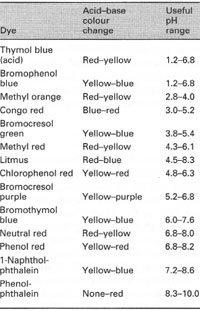Measuring pH
pH electrodesAccurate pH measurements can be made using a pH electrode, coupled to a pH meter. The pH electrode is usually a combination electrode, comprising two separate systems: an H+-sensitive glass electrode and a reference electrode which is unaffected by H+ ion concentration (see Fig. 7.2). When this is immersed in a solution, a pH-dependent voltage between the two electrodes can be measured using a potentiometer. In most cases, the pH electrode assembly (containing the glass and reference electrodes) is connected to a separate pH meter by a cable, although some hand-held instruments (pH probes) have combination electrodes and meter within the same assembly, often using an H+-sensitive field effect transistor in place of a glass electrode, to improve durability and portability.
Box 7.1 gives details of the steps involved in making a pH measurement with a glass pH electrode and meter.
pH indicator dyes
These compounds (usually weak acids) change colour in a pH-dependent manner. They may be added in small amounts to a solution, or they can be used in paper strip form. Each indicator dye usually changes colour over a restricted pH range (Table 7.2): universal indicator dyes/papers make use of a combination of individual dyes to measure a wider pH range. Dyes are not suitable for accurate pH measurement as they are affected by other components of the solution including oxidizing and reducing agents and salts. However, they are useful for:
|
|





